- V
- GF
- NS
- DF
- View Recipe Key
How to Make Classic French Financiers, with Flavor Variations
How to Make Classic French Financiers, with Flavor Variations
Everything you need to know about French financiers, the elegant tiny cakes you can serve for tea or dessert, or make as a delicious edible gift. Includes several flavor variation ideas!
This post contains affiliate links. Full disclosure is at the bottom of the article.
French financiers have long been at the top of my list of go-to desserts. I love them with all my heart because, despite their fancy name and elegant appearance, they’re super easy to make (if you can make muffins, you can make financiers!), and they’re extremely versatile: you can make them with any type of nut and garnish them with any fresh or roasted fruits, dried fruits or citrus zest, or even chocolate chips. What’s more, you can (and should) make financier batter in advance as it will keep in the fridge for a few days—all of which makes French financiers the ultimate stress-free dessert.
I’ve shared many financier recipes in the past, but it occurred to me I’d never done a deep dive into a classic French financier recipe. This post gathers all my tips for making this delightful tiny French cake from scratch.
What are financiers?
Financiers are rich, tiny cakes made with almond flour, brown butter, and egg whites. Usually baked in small molds, financiers are traditionally rectangular in shape, but they’re also often made in round molds, such as the ones in a mini-muffin pan.
Do I need a financier pan to make French financiers?
French financiers are traditionally made in small, rectangular molds, which makes them resemble tiny gold bars. This classic presentation is what gave the mignardise its name.
But rest assured: you do not need a financier pan to make French financiers. I wouldn’t want that to stop you from making this delicious treat! I actually have a financier pan and I never use it. I much prefer using simple muffin pans and mini-muffin pans.
When using muffin pans, I strongly recommend lining the cups with parchment paper liners, which you can get in regular and mini sizes. Unless your pans are non-stick and brand new, you should always line muffin cups. Financiers are likely to stick even to a thoroughly buttered pan because their batter is very sticky. Save yourself the trouble and simply use parchment paper liners for easy, breezy unmolding.
What ingredients do you need to make French financiers?
French financiers are made with staple ingredients that you may already have on hand:
- Toasted nuts
- Flour
- Sugar
- Baking powder
- Butter
- Egg whites
The one financier ingredient that requires careful sourcing is nuts. You can either purchase nut flour (finely ground nuts) or whole nuts that you will grind yourself (refer to the instructions below).
The easiest nut flour to find is almond flour, but pecan flour and hazelnut flour are also common. Nut flours are generally more expensive than whole nuts, though. Both can be purchased in bulk, which makes them more affordable. Always make sure to keep nuts (ground or not) refrigerated in an airtight container. Nuts can turn rancid quickly at room temperature, and because they tend to be expensive, it’s best to prevent waste. Do not store nuts in the freezer as the harsh conditions of a home freezer will damage the nuts.
If you have raw nuts on hand, it’s best to toast them before grinding them to make financiers. This will make them more flavorful. See my tips for roasting nuts below.
What type of sugar should I use to make financiers?
Classic French financiers are traditionally made with powdered sugar (also called confectioners’ sugar.) I prefer using a combination of granulated sugar and brown sugar: I find this duo provides the best texture and flavor. You can replace the granulated sugar by an equal amount of cane sugar or granulated maple sugar to contribute different flavor profiles to your financiers.
How to toast nuts
Preheat the oven to 325°F (160°C). Spread the nuts over a baking sheet and bake for 8 to 12 minutes, shaking the sheet once during the process. Keep a close eye on the nuts while they are roasting to avoid burning them.
Pistachios are the most fragile of nuts, so they should take the least time to toast (about 8 minutes). Almonds and walnuts will require longer to toast properly (about 12 minutes).
Nuts are ready when they release their lovely aroma. Trust your nose because a change in color may not be discernible! Let toasted nuts cool completely before storing them in an airtight container or using them in financiers.
How to grind whole nuts to make financiers
The easiest way to grind nuts is to add them to a food processor along with the flour. This will ensure the nuts grind evenly and don’t turn to butter. Simply combine the nuts and flour and process until finely ground. Scrape down the sides of the bowl once or twice to make sure the nuts grind evenly.
Do I really need to brown the butter to make financiers?
One central flavor component of classic French financiers is brown butter (beurre noisette, in French). Brown butter is made by melting butter in a saucepan, then letting it simmer for 5 to 7 minutes, until its water evaporates and milk solids caramelize. Brown butter is easy to make (see my tips below) and incredibly aromatic. It gives financiers a truly special flavor.
Rest assured, though: if you’re in a hurry, you can skip the browning step and simply use melted butter. In fact, I often skip browning butter when I make financiers with ingredients that have a strong flavor, such as cranberries or lemon zest. The aroma of these ingredients can overshadow the nutty flavor of brown butter, so it’s not worth the extra step.
How to make brown butter
Place the diced butter in a small stainless steel saucepan. A stainless steel saucepan makes the color of the butter more conspicuous, which will help you know when it’s ready to pull off the heat. Set over medium heat and stir until the butter is completely melted. Keep simmering over medium-low heat, swirling the pot from time to time. As the water evaporates, the butter will bubble up. This may prevent you from properly seeing what color the butter is, so, from time to time, simply lift the saucepan off the heat and gently swirl it for a few seconds until the bubbles recede, check whether the butter has started browning, then put it back on the heat if the butter is not ready.
Brown butter is ready when the milk solids at the bottom of the pot turn golden brown and the concoction gives off a deliciously nutty aroma. When it does, remove the butter from the heat, pour it in a small bowl, and let cool completely. (The whole process should take about 5 minutes.)
Brown Butter Video
Brown butter is an essential ingredient in French financiers. Browning butter is an effortless French technique that turns regular butter into an incredibly aromatic, sophisticated ingredient you can use in savory and sweet dishes. Learn how to make it by watching my short how-to video!
Can I make French financiers ahead of time?
Yes, you can! In fact, French financiers are the make-ahead dessert of your dreams. You can stir financier batter together, then refrigerate it in an airtight container for up to 1 week. Financiers are at their very best when freshly baked, or ideally eaten within 48 hours.
One of the joys of freshly baked financiers is the contrast between the crunchy edges and the buttery rich interior. After 24 hours in an airtight container, the texture of French financiers loses that contrast—they become more uniformly tender in texture—but they do remain delicious.
The fact that you can refrigerate financier batter for several days allows you to bake as many financiers as you need and enjoy them fresh, always.
Can I freeze French financiers?
The freezing and thawing process can soften French financiers a bit. If you bake financiers in advance and freeze them, make sure to store them in heavy-duty freezer bags for a maximum of 1 month. Thaw the financiers in the fridge overnight, or at room temperature for 30 minutes.
To return thawed French financiers to their freshly baked texture, reheat them in a 325°F (160°C) oven for 6 to 8 minutes, then let them cool to room temperature before serving.
How to make ingredient substitutions in French financier recipes
Classic, brown butter French financiers are pretty perfect bites. But to switch things up, you can substitute any ground nut for the almonds at a 1:1 ratio. Hazelnuts, pecans, pistachios, and walnuts all create outstanding financiers.
You can also easily add a layer of flavor by incorporating a generous amount of grated lemon or orange zest to financier batter. Make sure to carefully scrub citrus fruits before you use them (using unsprayed, organic citrus fruits is best), and use a Microplane to grate the citrus zest very finely. Add 2 tbsp (30 ml) of finely grated citrus zest to the financier batter for the best flavor (that’s about 2 lemons, or 1 orange.)
Get creative with toppings: You can top financiers with an almost infinite array of ingredients and produce different results with a single batch of batter. For example, you could whip up a batch of classic French financier batter, scoop it into prepared cups, and top them with 3 or 4 different fruits (raspberries, blueberries, and cherries, for example) and easily create a stunning array of treats without breaking a sweat.
Flavor variations for French financiers
Once you get the hang of making classic financier batter, you can let your imagination go wild and basically make them with any nut and garnish them with any and every fruit. During the holidays, I even like to make a breathtaking financier cake!
Get inspired! Here are perfect flavor combinations for French financiers:
- Almond and apricots
- Almond and cranberries
- Almond and plums
- Hazelnut and blueberries
- Hazelnut and cherries
- Hazelnut and figs
- Hazelnut and chocolate chips
- Pecan and apricots
- Pecan and peaches
- Pecan and raspberries
- Pistachio and lemon zest
- Pistachio and peaches
- Pistachio and raspberries
- Walnut and caramelized apples
- Walnut and chocolate chips
- Walnut and orange zest
If you want to make a French financier cake, make sure to refer to my recipe for Black Sesame and Chocolate Financier Cake, which provides advice about pans and extra tips to create a financier cake that will remain moist for days.
I sure do. Here are links to the other financier recipes that live on my blog:
- Maple Financiers
- Wild Blueberry Financiers
- Maple-Roasted Fig and Hazelnut Financiers
- Fresh Cranberry and Hazelnut Financiers
- Black Sesame and Chocolate Financier Cake
I also shared creative French financier recipes in my cookbooks, Simply Citrus and French Appetizers.
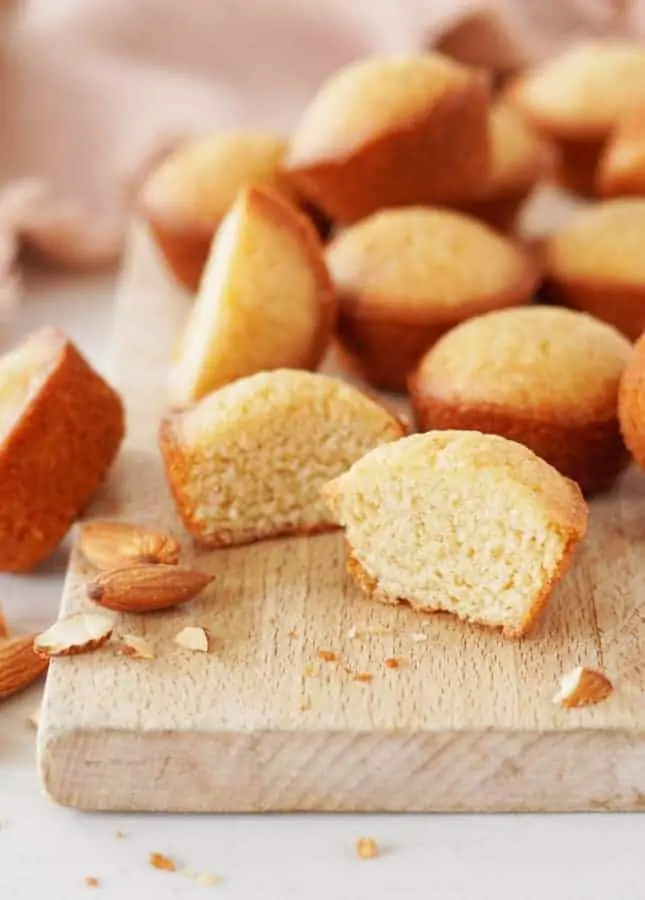
Classic French Financiers
Ingredients
For the French financiers
- ½ cup butter
- 1 cup almond flour
- ½ cup all-purpose flour
- ½ cup granulated sugar
- ½ cup brown sugar, packed
- ½ tsp baking powder
- 4 large egg whites 120 g
Flavoring options (choose one!)
- 2 tbsp finely grated lemon zest (about 2 lemons)
- 1 tbsp finely grated orange zest (about 1 orange)
- 1 tbsp pure vanilla extract, or 1 tsp (5 ml) vanilla bean paste, or grated seeds from half a vanilla bean
Topping options (optional)
- Fresh raspberries, one per financier or blueberries (2 to 4 per financier, depending on the size of the blueberries)
- Thinly sliced pieces of stone fruits, peaches, apricots, plums, about 2-3 small pieces per financier
- Dark chocolate chunks, 1-2 per financier or dark chocolate chips (2-3 per financier)
- Sliced or chopped nuts
Instructions
- To brown the butter: Heat the butter in a small stainless steel pot over medium heat until completely melted and simmering. Keep on cooking over medium-low heat, swirling the pot from time to time. If the butter bubbles up preventing you from watching closely over the color changing (that’s the water evaporating), lift the pot off the heat for a few seconds until the bubbles recede, then put it back on the heat.The butter is ready when the milk solids at the bottom of the pot turn a light brown color and the concoction gives off a delicious nutty aroma. When it does, remove the butter from the heat, pour into a small bowl, and let it cool for 10 minutes. Watch my short video to see how easy it is to make brown butter.
- In a large mixing bowl, whisk together the almond flour, all-purpose flour, granulated sugar, brown sugar, baking powder, and citrus zest, if using. Add the egg whites and whisk until they are fully incorporated and the mixture is thick and somewhat sticky. Mix in the brown butter and vanilla, if using, whisking gently at first to incorporate, then giving it a vigorous stir to allow the batter to fully come together. Transfer the batter to an airtight container and refrigerate for 1 hour, or for up to 1 week.
- When ready to bake the financiers, preheat the oven to 350°F (175°C). Line a muffin pan or a mini muffin pan with parchment paper liners (see notes) or grease a financier pan with softened butter, then sprinkle with flour and tap out the excess. (Make sure to grease the pan even if it is made of silicone.)
- Drop a tablespoonful of dough in each cup. (You can use a small cookie scoop to do this quickly.) Sprinkle each financier with fruits or toppings, if using. Bake for about 12 minutes for mini muffin pans, or about 15 minutes, for regular muffin pans, rotating the pan halfway through. The financiers are done when they are golden brown around the edges and set in the center. Let cool for 10 minutes in the pan, then transfer to a cooling rack to cool completely.
- STORAGE: Store in an airtight container at room temperature for up to two days. Always bring the financiers back to room temperature before eating for the best flavor.
- French financiers can also be frozen. Store them in heavy-duty freezer bags for a maximum of 1 month. Thaw the financiers in the fridge overnight, or at room temperature for 30 minutes.
- To return thawed French financiers to their freshly baked texture, reheat them in a 325°F (160°C) oven for 6 to 8 minutes, then let them cool to room temperature before serving.
NOTES:
- This recipe recommends using regular muffin pans or mini-muffin pans because they can commonly be found in most kitchens. You can also use a specialty financier pan, but keep a close eye during the baking process and adjust the baking time accordingly.
- To brown butter, it’s best to use a stainless steel saucepan because it’s easier to keep a close eye on the butter changing color against the pale gray metal. If you use a non-stick pan, you can use a spoon to scoop up some butter to check for doneness throughout the cooking process (just make sure to dip the spoon all the way down to the bottom of the pan to get some of the milk solids).
Did you make this?
Tell me how you liked it! Leave a comment or take a picture and tag it with @foodnouveau on Instagram.
This site is a participant in the Amazon Associates Program, an affiliate advertising program designed to provide a means for the site to earn fees by linking to Amazon and affiliated sites.
If you click on an affiliate link, I may earn advertising or referral fees if you make a purchase through such links, at no extra cost to you. This helps me creating new content for the blog–so thank you! Learn more about advertising on this site by reading my Disclosure Policy.
Author: Marie Asselin

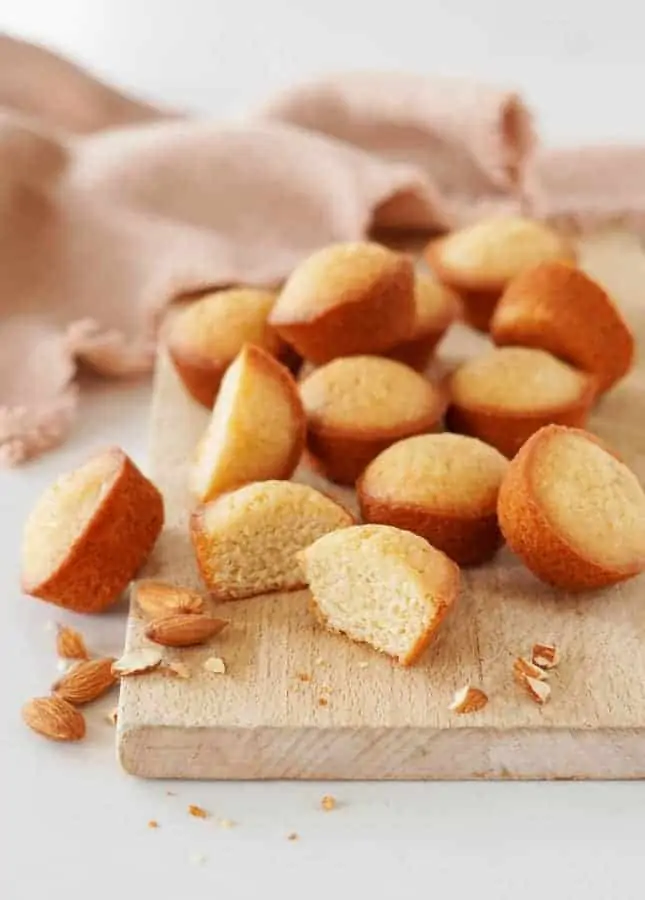
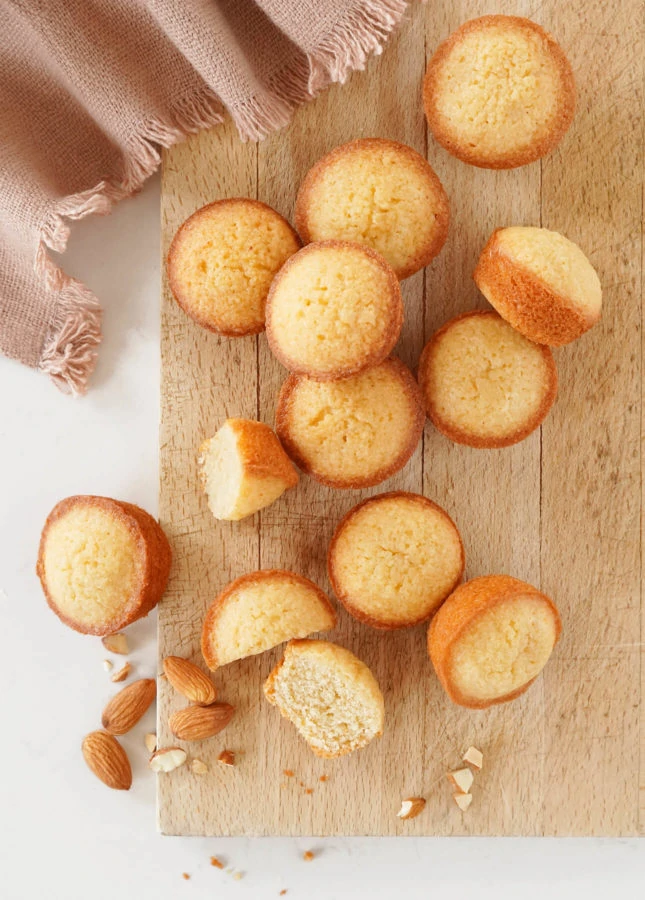

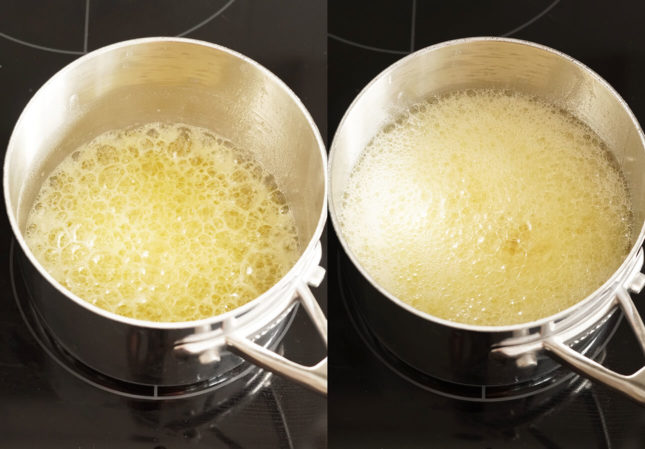
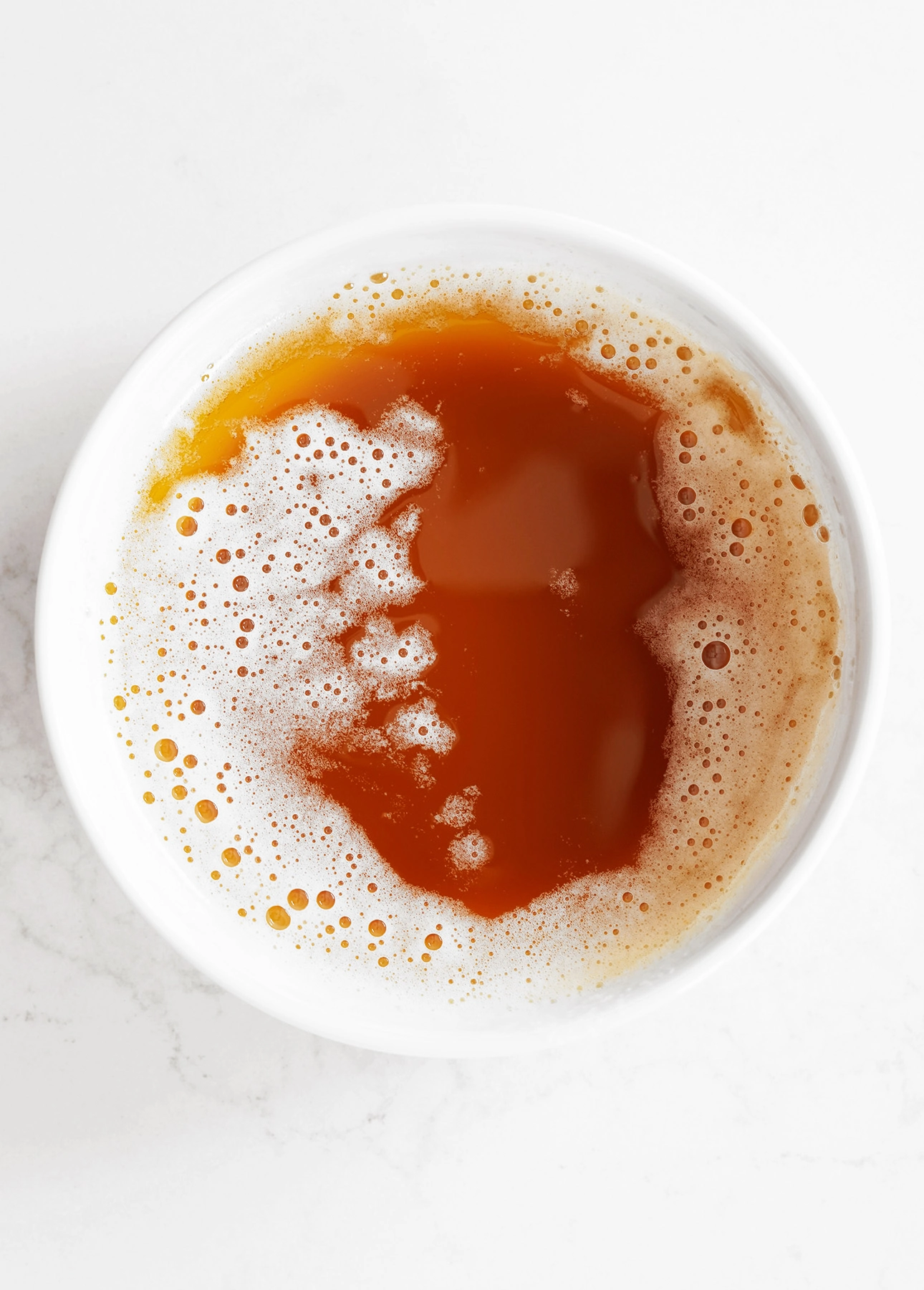

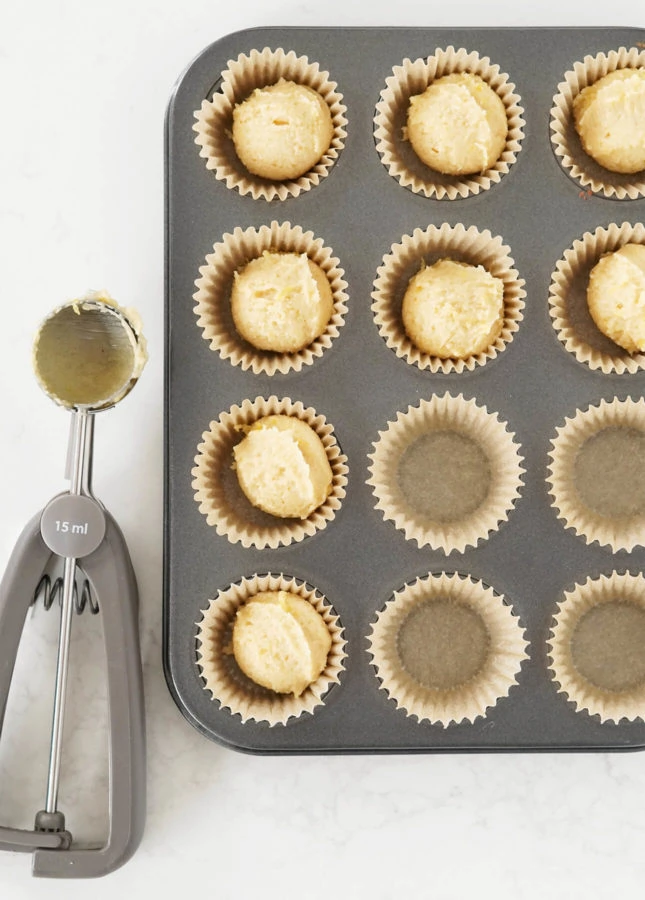
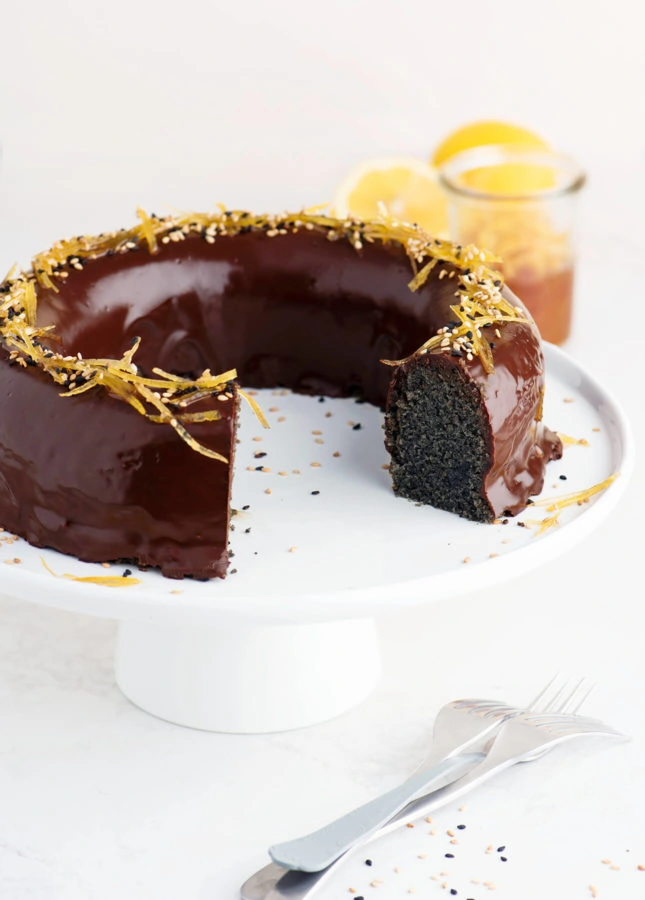


Great directions with so many options to tweak and have fun with.
Thanks for the kind comment Rodney! Which flavor will you try first? 😉
how many financiers does this yield?
This recipe yields about 36 bite-sized financiers!
I really like your article on French financiers and will be trying them. My question is can i used tried fruit should as dried cherries or dates?
Ellen
Hello Ellen! The great thing about financiers is that they’re super versatile! I think dried fruits would be great in them. I would chop them up finely and mix them through the financier batter so you get a little bit in every bite. Don’t be afraid to add spices into the mix, I think they would work well, especially with dates!
These turned out so great ! Seemed very dense by the looks of it. But they were so very moist and tender.. loveliest! Thanks for this recipe
Yes, financiers have a pretty dense crumb, yet they’re so surprisingly light and fluffy in texture! This is exactly why I love them so much! 😍